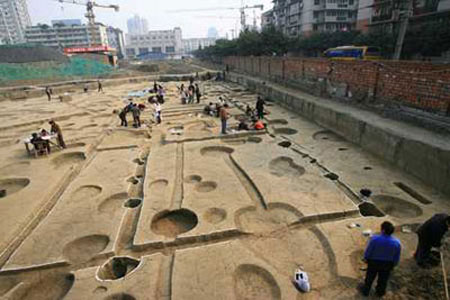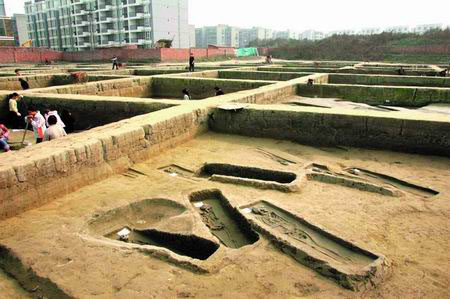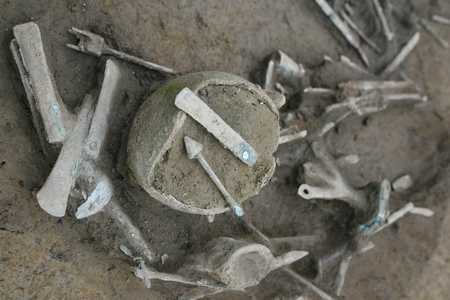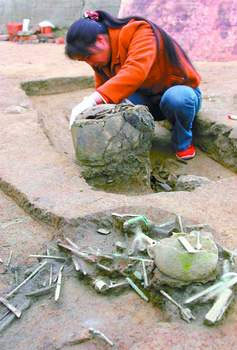| Tools: Save | Print | E-mail | Most Read |
| 3000 Year-old Jinsha Coming to Life |
| Adjust font size: |
The archeological site of Jinsha located in the western suburbs of Chengdu, the capital city of Sichuan Province, is widely believed to have been the capital of the Shu Kingdom close to 3,000 years ago. After some burial grounds and sacrifice emplacements were recently discovered, a renewed effort was made to excavate Jinsha. This vigor has now revealed the outlines of the cemetery, living areas, palace remains and sacrifice grounds. Lying only 50 kilometers away from the famed Sanxingdui, Jinsha rose to prominence around 1000 BC and shared similar origins with Sanxingdui as can be seen from similar burial objects although unlike its hallowed neighbor, Jinsha had no city wall. So far, artifacts made from ivory, jade, bronze, gold and stone have been found at the site. Sanxingdui flourished from 3000 BC to about 800 BC, markedly earlier than Jinsha culture. Due to this, some historians have theorized that Jinsha's culture and influence succeeded Sanxingdui's after the latter was brought low by natural disasters. Over 800 tombs found
Experts revealed the complete excavation of the 1,000-square-meter palace area lying to the north of the site, next to the religious ceremony ground to the northeast. The residential and cemetery areas took up the central parts of the site. The diameter of Jinsha, at its apogee, would have comprised 5 square kilometers and the individual functionality of different areas speaks of the fairly high level of development attained by the city. Upon investigation, it was found that all the tombs faced a southeasterly direction and DNA testing has revealed that all the excavated corpses had been less then 30 years old at the time of their death, a fact attributed to frequent warfare. Each skeleton was surrounded by potteries and jade objects. An oddity when looking in ancient funerary customs is the presence of a jade knife in each body's chest, a very rare custom for the time. Another rarity was discovered when a tomb was found to contain two skeletons, buried side-by-side. Soil samples revealed that the area was turned from a living area into a cemetery although archaeologists are baffled as to why. Special tomb No. M1901
Zhang Qing, director of the Chengdu Municipal Cultural Relics and Archaeology Institute's Jinsha Site Archaeological Station, explained that "when we first found this tomb, we noticed it was different from the others -- it's larger than those surrounding it, being 2.5 meters in length and 1.4 meters in width. It contains peculiar articles, unlike those in other tombs. Most of the bodies in Jinsha were well-preserved but the one in M1901 was burned before burial, something very rarely seen." Zhang surmised that this represented an ancient sacrificial ceremony in which leaves and other objects were set ablaze on the body of the deceased. With the knowledge they now hold and although they cannot pinpoint the person's identity, archaeologists can reveal that this tomb did not contain a commoner but is also too small to have contained the remains of a prince or nobleman. Thus, Zhang explained, the man may well have been an ancient sorcerer or respected artisan. Sorcerers conducted all of Jinsha's sacrificial ceremonies and by the luxurious items found in the sacrificial areas of Jinsha, it can be seen that sorcerers were held in high esteem. The other conjecture is that the unknown man could be a high-level craftsman, who were highly praised at the time for their unique skills, Zhang explained. Experts will now use "carbon 14" dating test to determine the precise age of the M1901 skeleton and his tomb. Rare bronzewares
Archaeologists were originally baffled as to whether these were ornaments, toys or served another purpose. For his part, Zhang held the belief that these articles were simply funereal objects which served as a status symbol for the deceased they accompanied. Besides these miniature tools, other crossed bronze artifacts were unearthed, with the particularity of having been cast in a wholly original manner for the time. "Ancient people of Jinsha had discovered a new method of casting bronze, known as piece-mould casting method. A model of the object to be cast was first made and turned into a mould. The mould would then have sections cut away from it to release the original model. The sections would then be individually strengthened with fire before being reassembled to form a solid mould ready for casting. If the object to be cast was a vessel, a core would be placed inside the mould to ensure the vessel's cavity," Zhang Qing explained. Jade chisel
The jade chisel, measuring around ten centimeters long and in good condition, is the second of its kind in the Jinsha Ruins. Its discovery will be highly valuable in providing research on sacrificial vessels of the time. 3,000-year-old bark-roofed house The ruins also revealed remains of houses. Ancient houses were worn down to their foundations when archaeologists arrived but the humid climate around Chengdu allowed the wooden frames and bark roofs to be partially preserved, explained experts. One house had covered around 30 square meters, with a roof wholly made of bark measuring 7 by 3 meters. After analyzing the wood, the house was thought to have been built towards the end of the Shang Dynasty (c. 1600 BC - c. 1100 BC). (China.org.cn by Chen Lin, April 3, 2007) |
| Tools: Save | Print | E-mail | Most Read |
 |
| Related Stories |
|



